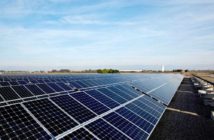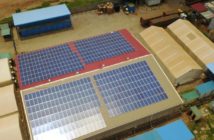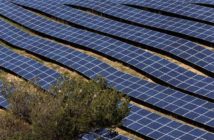By Bruce Newman
MOUNTAIN VIEW — Bertrand Piccard was flying from Morocco to Spain last year — finishing up another highly successful test of Solar Impulse, the revolutionary airplane he helped design that gets all its power from the sun — when he made a profoundly disturbing discovery: he was actually flying backwards.
At 3,500 pounds, Solar Impulse weighs less than a Hyundai, and its four motors each generate only 10 horsepower, about the same as a motor scooter. Its trim body design makes the plane highly susceptible to headwinds, which at that moment meant Piccard and his Pterodactyl-shaped solar array were at 27,000 feet, going in reverse. “That was an interesting experience, quite strange to live,” Piccard said Thursday at
the plane’s first public appearance, inside Moffett Airfield’s historic Hangar 2.
If the winds are at its back, that fate will not befall Solar Impulse when it embarks on its most ambitious journey May 1, setting out across America on an adventure that’s not scheduled to finish until early July at New York’s JFK Airport. That’s not far from Roosevelt Field on Long Island where Charles Lindbergh took off in 1927 on aviation’s first trans-Atlantic solo flight. “This airplane could do it nonstop,” said co-pilot and project CEO André Borschberg, “but because the pilot is not as sustainable as the technology, we have limited ourselves to 24-hour flight duration.”
are planned in four cities along the way — but even with the ability to fly day and night using only the sun’s power, it’s no speed demon. With the wind at its back, the plane cruises at 35 mph, about half the speed of the airship Hindenburg.
Born explorer
If all goes well during its first big endurance test, Solar Impulse will attempt to circumnavigate the globe in 2015. That trip will require at least one nonstop stint of five days and extremely nervous nights over the Pacific. The cockpit can only accommodate one pilot at a time, so Borschberg said he will use meditation and Piccard will hypnotize himself while the plane flies on auto-pilot.
The plane looks like something you might install on your roof, although if all goes well during test flights over the Bay Area that begin next week, it won’t actually end up there. It’s basically a giant wing with a glider’s fuselage and a Port-A-Potty attached. That’s where the project’s Swiss big cheeses, Piccard and Borschberg, sit in chilly solitude.
From wingtip to wingtip, Solar Impulse is wider than a jumbo jetliner, and yet everything else about it is meant to be lean and mean. It draws all its power from 12,000 solar cells,
each the thickness of a human hair, with the energy stored in a lithium polymer battery nearly identical to the one that powers the Tesla Model S.
At Thursday’s public rollout, an introductory video stalled briefly — one of the perils the plane confronts during flight — and when it resumed, Piccard’s voice was sped up as if he had inhaled helium. A balloonist who circled the planet in 1999, Piccard is a natural born adventurer, following a path similar to his grandfather Auguste, a renowned balloonist, and father Jacques, who in 1960 became the first to explore the Mariana Trench in a submarine.
“When I was a child, I was reading books about exploration, about aviation, about the conquest of space,” he said. His family moved to the U.S. because of his father’s work in 1968, a year before Apollo 11 landed on the moon, propelling Bertrand into suborbital flights of fancy. “Then I saw that the reality was much better than the dream.”
Future mystery
To bring the decade-long dream to life, the project’s co-founders have assembled a lineup of 80 sponsors, among them Schindler, the world’s largest manufacturer of elevators and escalators. An executive from the company compared Piccard and Borschberg to the Wright Brothers, just before using the press gathering to announce the Schindler Solar Elevator. Schindler’s Lift?
Even in the darkened hangar, the sun always seemed to be shining on Solar Impulse, with one speaker after another extolling its promise. But the technology has aroused at least modest skepticism.
“This is something to capture the imagination of kids, of innovators,” said Ben Lenail, director of business development at AltaDevices, a Sunnyvale company that manufactures thin solar cells with a far more practical application — powering drones already used by the military. “You have to have everything go right. It’s a beautiful dream, but in terms of practical application, I think we’re still about 15 years away.”
Piccard was asked at one point if Solar Impulse — which is already being redesigned for the trip around the world in two years — is the airplane of the future. “It would be crazy to answer yes, and stupid to answer no. Because today, we cannot imagine having a solar-powered airplane with 200 passengers. But in 1903,” he said, referring to the Wright Brothers’ first flight, “it was exactly the same. And when Charles Lindbergh crossed the Atlantic, he was alone on board, in an airplane full of gasoline. We don’t know what’s going to happen in the future. But we have to start.”
Contact Bruce Newman at 408-920-5004. Follow him atTwitter.com/BruceNewmanTwit.
.








